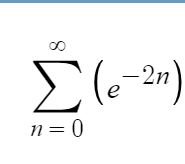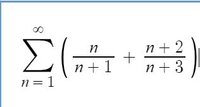You are using an out of date browser. It may not display this or other websites correctly.
You should upgrade or use an alternative browser.
You should upgrade or use an alternative browser.
Indefinite Series
- Thread starter NaN-Gram
- Start date
pka
Elite Member
- Joined
- Jan 29, 2005
- Messages
- 11,978
I think that it is fair to say that students are just expected to have learned some basic facts about the topics.How do you get that solution, though? I don't know how to actually equate that.
For example: If \(|r|<1\) then \(\sum\limits_{n = K}^\infty {A{r^n}}\) is the summation of a geometric sequence in which \(Ar^K\) is the first term and \(r\) is known as the common ratio. Terms may differ from course to course. But the sum equals \(\dfrac{Ar^K}{1-r}\): in words, the sum is the first term divided by one minus the common ratio.
topsquark
Senior Member
- Joined
- Aug 27, 2012
- Messages
- 2,363
Please check to see if there is a typo. This sum does not converge. Are we, perhaps, subtracting the two series?
[math]\sum_{n = 1}^{ \infty } \left ( \dfrac{n}{n + 1} - \dfrac{n +2}{n + 3} \right )[/math]
Or are you supposed to show that it doesn't converge?
-Dan
Dr.Peterson
Elite Member
- Joined
- Nov 12, 2017
- Messages
- 16,871
If by "questions" you mean "summations", you can't split them, because neither of them converges, as the terms in each case approach 1, not 0. That also implies that their sum approaches 2, so the whole summation can't converge. I agree with topsquark in questioning it.As for the dual fraction question, I realize that I can also split it into two separate questions as well. Those would be n/(n+1) and (n+2)/(n+3). Again, I got stuck at that point, and I need help to proceed on both questions.
Dr.Peterson
Elite Member
- Joined
- Nov 12, 2017
- Messages
- 16,871
I'm supposed to show why an expression might diverge, or what the expression converges to.
It's very important, as mentioned here, that you state the entire problem you are asking about, including its instructions! Now we know.
Have you been told enough now to answer the question, in one case showing what it converges to, and in the other why it doesn't converge?
topsquark
Senior Member
- Joined
- Aug 27, 2012
- Messages
- 2,363
Combine the two fractions:I still don't know how to handle the twin sums. I feel that I need a hint to continue, aside from splitting up the expression.
[math]\dfrac{n}{n + 1} + \dfrac{n + 2}{n + 3} = \dfrac{(n)(n + 3) + (n + 2)(n + 1)}{(n +1)(n + 3)} = \dfrac{n^2 + 3n + n^2 + 3n + 2}{(n + 1)(n + 3)} = \dfrac{2n^2 + 6n + 2}{(n + 1)(n + 3)}[/math]
[math]\sum_{n = 1}^{ \infty } \left ( \dfrac{n}{n + 1} + \dfrac{n + 2}{n + 3} \right ) = \sum_{n = 1}^{ \infty } \dfrac{2n^2 + 6n + 2}{(n + 1)(n + 3)}[/math]
So the term [math]a_n = \dfrac{2n^2 + 6n + 2}{(n + 1)(n + 3)}[/math]. There are a bunch of tests for convergence you can use from this point on but probably the simplest is to find [math]\lim_{n \to \infty } \dfrac{a_{n + 1}}{a_n}[/math]. Give it a go.
-Dan


